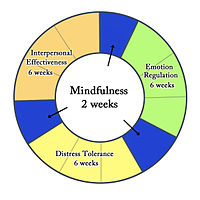
Photo from wikipedia
Objectives. We aimed to investigate the effects of brief supportive expressive group therapy with mindfulness for cancer patients and to assess the utility of heart rate variability (HRV) as a… Click to show full abstract
Objectives. We aimed to investigate the effects of brief supportive expressive group therapy with mindfulness for cancer patients and to assess the utility of heart rate variability (HRV) as a biomarker of distress and treatment effect. Methods. A total of 28 female patients with nonmetastatic cancer at a university hospital in South Korea received a 4-week modified group therapy for distress reduction. The BESTMIND (Brief Expression and Support Therapy with Mindfulness) program consisted of supportive–expressive group therapy and mindfulness-based stress reduction. The subjective outcomes of distress, anger, sleep quality, and sense of well-being and the physiological outcome of HRV were assessed before and after the program. Results. After the program, patients showed significantly reduced distress, perceived stress, anger, and sleep disturbance and increased quality of life. No significant change was observed in the degree of mindfulness. A significantly increased SD in the normal beat-to-beat intervals and normalized high-frequency (HF 0.15-0.4 Hz) power from spectral analysis were observed after treatment. According to the correlation analyses, HF power correlated with depression scores, and normalized HF power was associated with depression, anxiety, perceived stress, and anger at baseline. The pretreatment and posttreatment comparison indicated that an increase in HF power was associated with a decrease in anger. Conclusions. These results suggest the effectiveness of this modified group-based program for distress reduction and also provide preliminary evidence for the use of HRV as a biomarker of distress and recovery. HF power from HRV variables may serve as a quantitative biomarker of the treatment response of distress management, including anger.
Journal Title: Integrative Cancer Therapies
Year Published: 2018
Link to full text (if available)
Share on Social Media: Sign Up to like & get
recommendations!